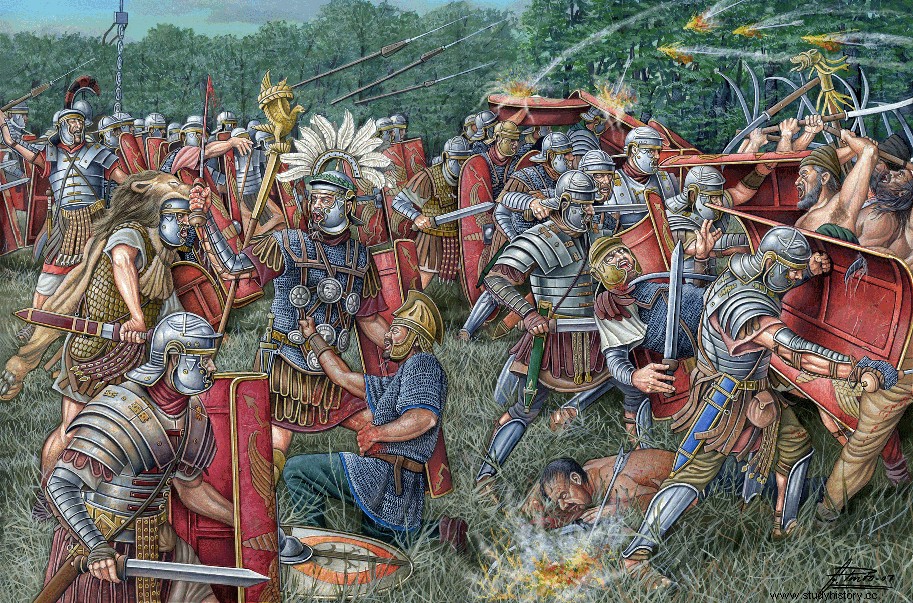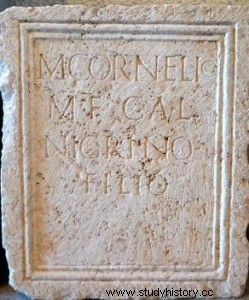There is no Cordovan who does not boast of the wisdom of his Seneca , nor Calagurritano who is not proud of his Quintiliano , nor bilbilitano that does not quote his satirist Marcial , nor poncino who does not praise the glories of his beloved Trajan , four illustrious exponents of our prolific Roman Hispania, but… Are we Valencians aware that these lands also saw the birth of a man as charismatic and important as all those mentioned above? Most don't, unfortunately. Let's discover a great name for the history of this corner of the world, worthy of streets, squares and statues throughout the Camp del Turia.
At the end of the 1st century AD, with more than a century of peace and prosperity in Edetan lands, trade and agricultural activities had recovered from the disastrous rebellion of Quintus Sertorius . During the principality of Augustus the great road that crossed the current Region of Valencia from north to south was renovated, and it was granted the title of Municipium Civium Romanorum to the new Edeta/Lauro (the old Iberian city was burned and abandoned after the Sertorian assault) and the colony Valentia it was refounded and repopulated. Thus, the valley of the Turius it became a territory so intensely Romanized that it soon gave the Empire a man to be very proud of. We are talking about the great Nigrino .
Marcus Cornelius Nigrinus Curiacio Materno , of the Gallery tribe , was born in Edeta around 40. From a presumably indigenous family, perhaps a second-generation descendant of those Edetan auxiliaries who served with the princeps in civil wars and who obtained citizenship and land with the Pax Romana , was the son of M. Cornelius Nigrinus and Maternal Curiacia and fruit of a marriage that brought together two wealthy families from the Tarraconense and Betica respectively. In the case of these Cornelios, his good economic position was due to the ownership of mines of lapis specularis (mirror, the translucent plaster that was used as glass in the windows) in Segobriga (today Saélices, Cuenca). The many sesterces that he obtained from such a farm in full Roman constructive euphoria, something that unfortunately sounds familiar to us, catapulted him into the local government of Edeta, forming part as a young decurion in the ordo equester until he was appointed as military tribune of the Legio XIV Gemina in Britannia.

On the island of mists the meteoric cursus honorum begins of this distinguished edetane:between 63 and 69 he went to the limes of the Danube, where the emperor Vespasian granted him the honorary privilege Adlectio Inter Praetorios . After this stage he was promoted to legate, serving in the VI and VIII Augusta in Germania and Aquitaine respectively. In the year 83 he went to Rome as deputy consul, leaving a year later as governor of Moesia (approx. today's Bulgaria). a stable and civilized kingdom that rivaled Rome for control of the banks of the Danube. Between his arrival in Moesia and his second and third consulate between 86 and 89 he got more decorations than any other military man of the time:two vallaris crowns (the first to storm an enemy camp), two muralis (first to climb an enemy wall, two civilians (the first to save a teammate's life), two navalis (the first to board an enemy ship) and eight banners . The Edetane Marco Cornelio Nigrinus he was one of only five senators to achieve these decorations together (only bettered by Vespasian and ahead of his contemporaneous and great competitor, Marcus Ulpius Trajan ), in addition to being one of the only senators who obtained three consulates without being from the imperial family and did not end up sitting on the throne of Rome.

Nigrino Tombstone
Domitian , second son of Vespasian and one of the most psychopathic rulers that ancient Rome gave, he became obsessed at the end of his days with putting men of impeccable loyalty at the head of the most relevant provinces. Within that deployment, Nigrinus was sent to Syria, the bastion of Rome against its secular enemy, the Parthian Empire, where he served as praetor between 95 and 97. This year in particular, 97, marks the abrupt end of the career politics and military of our hero, a date that coincides with the adoption of Trajan by the old emperor Nerva. From here there are already speculations about why Marco Cornelio Nigrinus is relegated from his functions and disappears from public life, supposing that he returned to his native Edeta and died around the turn of the century. Some historians speak of a damnatio memoriae , the erasure of any sign or memory of the existence of someone that was decreed by the Senate or by the princeps on duty to eliminate his enemies even from memory. In my opinion, perhaps it was so and the new princeps Trajan, fearful that his greatest competitor could represent a future threat, left him unprepared and without work and sent him back home, or perhaps Nigrinus himself, already close to sixty years old and over forty away from Edeta serving the eagles from Britain to Syria, wished for a well-deserved retirement in his villa along the murmuring banks of the Turius . The curious case is that only in Llíria have five inscriptions related to Nigrinus been found, where his public positions and decorations are listed, since neither Dion Casio nor Plinio comment on him in their contemporary texts (being a military hero without comparison in his time ), nor is there any inscription about him in all of Rome... It does look like a damnatio memoriae , except for the bravery or unawareness of what it means to ignore such a strict law. It is thought that the Mura thermal complex, in Pla de L'Arc, was a lavish civil work, most likely promoted and financed by Nigrino to provide his small hometown with baths and a civic center typical of a large city. In fact, it is the largest recreational-religious complex of this type in all of Hispania.

This is the most complete inscription found in Llíria:
Marcus Cornelius, son of Marcus of the Galeria tribe, Nigrinus Curiatio Materno, consul, military tribune of the gemina XIII legion, praetor with the emperors Vespasian and Titus, Augustus legate of the VIII Augusta legion, proppraetor of the Aquitaine Province, propraetor legate of the province of Moesia, received for the war in Dacia two mural crowns and two wall crowns and two classical crowns and two golden crowns and up to eight hasta purae and eight vexiliae, Augustus propraetor legate of the province of Syria.
Collaboration of Gabriel Castelló , author of Archienemies of Rome .
Illustration:History Brushes
